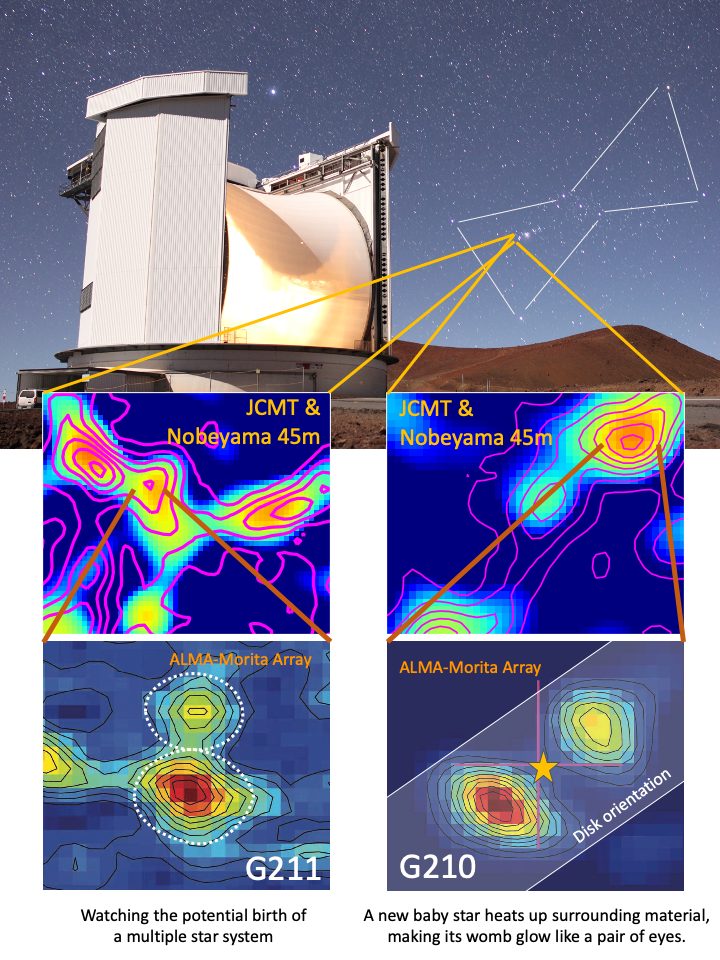The JCMT SCOPE Survey has provided astronomers studying the formation of stars a treasure map for follow up observations by the Nobeyama 45-m radio telescope and ALMA to reveal the treasures within. Two such treasures include an image of a multiple star system on the cusp of formation alongside a rare glimpse of a baby star heating up its surrounding material making its womb glow like a pair of eyes. These results were published in a number of papers produced this week in the Astrophysical Journal.
Dr. Tie Liu, Shanghai astronomer – and until last summer – a visiting researcher in Hilo Hawai`i has been hunting baby stars for over a decade. He is the Principle Investigator of the JCMT SCOPE survey that observed over 3,500 sites where stars were believed to be on the cusp of formation within the Milky Way, these sites are known to be dense cores. The dense cores are “a treasure trove for astronomers investigating the very early phases of star formation” said Tie Liu when asked about the survey, noting that “It’s great that we have powerful tools such as ALMA but ALMA has such a small field of view you need a telescope like JCMT to know where to look!”

Figure 1. Top: image of the JCMT with the Orion constellation highlighted (image credit William Montgomerie). Middle: N2H+ maps obtained with the Nobeyama telescope with 850 micon JCMT/SCUBA-2 contours overlaid. In the Middle image the team identified a number of dense cores. Bottom: The ALMA-Morita Array reveals two different substructures within each dense core. Bottom left: multiple stars are seen being formed in the early starless core phase (source G211). Bottom right: a mysterious pair of eyes appear to peer out from the disk around the newly forming star – these highlight rich chemistry occurring in the disk of this newly forming star (Results presented in Tatematsu et al. 2020).
Taking advantage of the JCMT treasure map of dense cores produced by the JCMT SCOPE team is an international research team lead by Gwanjeong Kim and Ken Tatematsu of the Nobeyama Radio Observatory (NRO), Japan. The team have observed over of the 200 dense cores, with the NRO 45-m radio telescope and the Morita Array, which is the East-Asian constructed part of the world’s most powerful radio telescope ALMA.
When discussing the chosen cores to observe with ALMA, Ken Tatematsu, director of NRO and the co-PI of the SCOPE project in Japan stated “We are able to locate exact places for near-future star formation, by using the fact that the deuterium percentage reaches its maximum just at the time of star formation”. Deuterium, which is a special kind of hydrogen, was carefully measured by the team in over 100 cores located in the Orion constellation,with the Nobeyama-45m radio Telescope.
The two rare finds discovered by the team are shown in Figure 1. An image of a multiple star system on the cusp of formation and a glimpse of a baby star heating up its surrounding material making its womb glow like a pair of eyes. Ken Tatematsu said “what’s exciting is that in the pseudo-disk of the dense core G210, we see these two bright eyes staring back at us – this is the region around the baby star being heated and undergoing a chemical change. Usually such detail is hidden from view, but not anymore!”
As to the question why this is such a great find, co-author on this work Tie Liu noted that “from the chemical models such examples as we have found should be quite common, but without the resolution we cannot see the structure. JCMT is the perfect telescope for finding such candidates but we do then need to draw on the power of a telescope such as ALMA”.
These results give us important clues to understand how stars start to form. Commenting on the future of this work Tie Liu said “We will do more systematic studies of these SCOPE dense cores with high resolution interferometric observations (e.g. ALMA), who knows what other treasures will be found”.This work has been published in the following three papers:
- Tatematsu et al. 2020 “ALMA ACA and Nobeyama Observations of Two Orion Cores in Deuterated Molecular Lines”
- Kim et al. 2020 “Molecular Cloud Cores with High Deuterium Fraction: Nobeyama Single-Pointing Survey”
Supplementary Information
With a diameter of 15m (50 feet) the James Clerk Maxwell Telescope (JCMT) is the largest astronomical telescope in the world designed specifically to operate in the submillimetre wavelength region of the electromagnetic spectrum. The JCMT is used to study our Solar System, interstellar and circumstellar dust and gas, evolved stars, and distant galaxies. It is situated in the science reserve of Maunakea, Hawai`i, at an altitude of 4092m (13,425 feet).
The JCMT is operated by the East Asian Observatory on behalf of NAOJ; ASIAA; KASI; CAMS as well as the National Key R&D Program of China. Additional funding support is provided by the STFC and participating universities in the UK and Canada. Supplementary Information about SCUBA-2:
The James Clerk Maxwell Telescope (JCMT) observations were obtained using the “Submillimetre Common User Bolometer Array 2”, a specialized camera known by its acronym, SCUBA-2. SCUBA-2 consists of 10,000 superconducting Transition Edge Sensor (TES) bolometers that allow for simultaneous observations at wavelengths of 450 and 850 microns. Scientists regularly use SCUBA-2 to observe star-forming regions and other astronomical regions and phenomenon.
Supplementary Information about the JCMT SCOPE survey:
- Liu et al. “The TOP-SCOPE Survey of Planck Galactic Cold Clumps: Survey Overview and Results of an Exemplar Source, PGCC G26.53+0.17”
- Eden et al. “SCOPE: SCUBA-2 Continuum Observations of Pre-protostellar Evolution – survey description and compact source catalogue”
Contact Information:
Dr. Tie Liu
Shanghai Observatory
Email: liutie@shao.ac.cn
Dr. Harriet Parsons,
East Asian Observatory, JCMT
Email: h.parsons@eaobservatory.org



